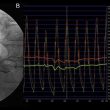The use of fractional flow reserve (FFR) and non-hyperemic pressure indices (NHPRs) have become essential for intermediate lesion revascularization. A linear inverse correlation has been recently shown between the use of post PCI physiology and cardiovascular events at followup. However, its adoption has been limited so far, seeing the wide variety of algorithms used in...
EuroPCR 2023 | Events after Redo TAVR in Balloon-Expandable Valves
With the treatment of aortic valve disease in younger patients, a significant number of them will need redo TAVR at some point in their life. However, to date there are few data on redo TAVR. The aims of this study was to look at real life experience on redo TAVR with balloon-expandable SAPIEN valves and...
Post PCI Angina: Inevitable or Avoidable?
Predictors of post PCI angina Among the complications of ischemic cardiomyopathy stenting, those called chronic, with significant functional and mental compromise, might affect patient quality of life. This can be observed in different scenarios, such as instent restenosis and post PCI angina. This kind of complications is associated with anxiety and depression at long term. ...
Redo Surgical Aortic Valve Replacement after Prior Transcatheter vs Surgical Aortic Valve Replacement: A Growing Population
Transcatheter aortic valve replacement (TAVR) has evolved since it was first implemented, and it is now also used to treat low risk patients. One of the questions this has raised is whether patient life expectancy is higher than prosthesis life expectancy. The growing population in need for valve replacement also poses the question of how...
Microvascular Dysfunction in Symptomatic Patients with Intermediate Coronary Lesions Prognostic impact according to different patterns
Coronary microvascular dysfunction (CMD) is emerging as an important cause of myocardial ischemia, and its role in the pathogenesis of cardiovascular disease—including angina patients with nonobstructive coronary lesions—is well known. Currently, there are several definitions of CMD and several invasive and noninvasive diagnostic tests. Using invasive tests, heterogeneous patterns of microvascular dysfunction, such as coronary...
Coronary Physiology after Aortic Valve Intervention
Impact of Aortic Valve Intervention on Coronary Flow Reserve Myocardial flow might be compromised in patients with severe aortic stenosis, which might be driven by CAD and concomitant atherosclerosis or a compromised capillary bed. Capillary circulation might be compromised by increased left ventricular mass (LVM) which in turn might alter coronary flow reserve (CFR). Multiple...
Can Drug Coated Balloon Be a Valid Option for Small Vessels?
One of the challenges of percutaneous coronary interventions (PCI) are <2.5 mm vessels, since complications and restenosis complications rate are higher than with >3.0 mm vessels. Drug Coated Balloons (DCB) can be a useful tool, but their efficacy and safety [vs. plain old balloon angioplasty] remains unclear. PEPCAD China SVD is a prospective and multicenter...
IN.PACT Study | Should We Start Using DCBs More Frequently in Cases of Femoropopliteal Disease?
With the new devices (drug-eluting balloons [DEB], drug-eluting stents [DES], and atherotomes) percutaneous treatment is becoming the first line of approach for femoropopliteal disease, especially when dealing with not very long total occlusions. Randomized studies and registries on the use of drug-coated balloons (DCB) in femoropopliteal disease are currently available, but their evolution beyond 2...
POKI: A New Bifurcations Strategy
This scientific article we briefly discuss the POKI technique, a new stent optimization strategy for bifurcation lesions. Coronary bifurcations represent 20 to 25% of percutaneous coronary interventions (PCI) and continue to be a real challenge at present; the different available treatment strategies are used to correct bifurcation carina after stenting seeing as incomplete strut apposition...
Resistant Obstructive Hypertrophic Cardiomyopathy: Myomectomy or Septal Ablation?
Approximately 70% of hypertrophic cardiomyopathies (HCM) are associated to a left ventricular outflow tract (LVOT) obstruction and mitral valve failure leading to dyspnea and cardiac failure in a high number of patients. Even though at present there are effective drug treatments combined with pacemaker implantation, surgery (septal myomectomy (SM) continues to be the first choice...









